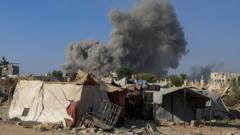The recent Israeli incursions into Gaza City have led to widespread destruction and loss of life. Reports indicate that Israeli air forces and ground troops have conducted relentless attacks, focusing on the northern and eastern regions as part of a broader strategy to seize control of the territory's most populated urban area.
Emergency services report that at least 64 individuals have died and nearly 300 others have been injured in attacks over the past 24 hours alone. The ongoing violence has pushed the total death toll to an alarming 62,686 since the conflict escalated on October 7, 2023, following a Hamas-led attack, which resulted in the deaths of around 1,200 people in southern Israel.
Prime Minister Benjamin Netanyahu has publicly committed to eradicating Hamas, despite facing mounting criticism both domestically and internationally. Approximately 60,000 reservists have been mobilized for this operation, poised to enter Gaza on a larger scale soon.
The Israeli Defense Forces (IDF) have reiterated their actions aim to eliminate Hamas presence and prevent further attacks. In this context, the destruction of buildings in the Jabalia refugee camp underscores the intensity of the operation, increasing fears for the safety of civilians caught in the crossfire.
The humanitarian crisis is exacerbated by the devastation to infrastructure, with the United Nations reporting dire conditions, including food shortages and the collapse of healthcare systems in Gaza. As famine conditions manifest in the region, international organizations are sounding alarms about the potential consequences of a full-scale ground invasion.
Negotiations for a ceasefire and hostage release have stalled, complicating the situation further. Mediators from Qatar and Egypt seek to broker peace, presenting proposals for temporary truces which Israeli officials have dismissed as inadequate. The unyielding stance of Netanyahu’s administration highlights the prevailing tension, with defense leaders indicating that Gaza City could face total destruction should negotiations fail.
As the Israeli military gears up for a significant escalation, the plight of civilians—many of whom have been displaced multiple times—remains precarious. The unfolding crisis illustrates the severe humanitarian implications of continued military action in a region already brought to its knees.
Emergency services report that at least 64 individuals have died and nearly 300 others have been injured in attacks over the past 24 hours alone. The ongoing violence has pushed the total death toll to an alarming 62,686 since the conflict escalated on October 7, 2023, following a Hamas-led attack, which resulted in the deaths of around 1,200 people in southern Israel.
Prime Minister Benjamin Netanyahu has publicly committed to eradicating Hamas, despite facing mounting criticism both domestically and internationally. Approximately 60,000 reservists have been mobilized for this operation, poised to enter Gaza on a larger scale soon.
The Israeli Defense Forces (IDF) have reiterated their actions aim to eliminate Hamas presence and prevent further attacks. In this context, the destruction of buildings in the Jabalia refugee camp underscores the intensity of the operation, increasing fears for the safety of civilians caught in the crossfire.
The humanitarian crisis is exacerbated by the devastation to infrastructure, with the United Nations reporting dire conditions, including food shortages and the collapse of healthcare systems in Gaza. As famine conditions manifest in the region, international organizations are sounding alarms about the potential consequences of a full-scale ground invasion.
Negotiations for a ceasefire and hostage release have stalled, complicating the situation further. Mediators from Qatar and Egypt seek to broker peace, presenting proposals for temporary truces which Israeli officials have dismissed as inadequate. The unyielding stance of Netanyahu’s administration highlights the prevailing tension, with defense leaders indicating that Gaza City could face total destruction should negotiations fail.
As the Israeli military gears up for a significant escalation, the plight of civilians—many of whom have been displaced multiple times—remains precarious. The unfolding crisis illustrates the severe humanitarian implications of continued military action in a region already brought to its knees.



















